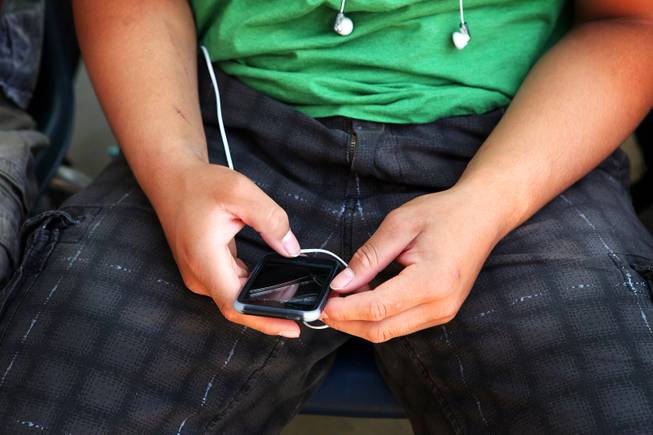
A students texts during a texting and driving presentation at Green Valley High School in Henderson on Wednesday, May 23, 2012.
Thursday, July 3, 2014 | midnight
Sexting is not a harmless activity that younger teens see as a substitute for real sex. A new study of Los Angeles middle school students finds that those who sent or received sext messages were significantly more likely than their nonsexting peers to be sexually active.
Indeed, the study found that sexting habits were a strong predictor of sexual activity. Compared with students who didn't sext, those who sent sext messages were 3.2 times more likely to be sexually active and those who received such messages were seven times more likely to have had sex, according to results published Monday in the journal Pediatrics.
"Sexting and sexual activity go hand in hand," the study authors concluded.
Sexting involves sending or receiving cellphone messages that have sexually explicit content. The messages may be text-only, though they often include photos as well.
Previous studies of high school students and young adults have found that those who sext are also more likely to be sexually active. But this study is among the first to focus on younger students.
"There is a debate among researchers as to the exact relationship between sexting and sexual behavior," wrote the study authors, from the University of Southern California's School of Social Work, the Los Angeles Unified School District and Sentient Research, a private firm based in West Covina, Calif.
In one camp are those who say younger kids see sexting as "an alternative to physical sexual behaviors (especially among early adolescents)," the researchers wrote. In the other are those who say "sexting is a part of contemporary adolescent sexual behavior."
To clarify the issue, the researchers added 27 questions to the Youth Risk Behavior Survey, which is administered by the Centers for Disease Control and Prevention. They gave their questionnaire to 1,320 sixth-, seventh- and eighth-graders attending schools in LAUSD and received 1,173 usable responses. The students' ages ranged from 10 to 15 (with an average age of 12.3).
Among the students, 74 percent either owned or had ready access to a cellphone capable of sending sext messages. And among them, 4.6 percent said they had sent at least one sext and 20.1 percent said they had received at least one sext, the study found.
Compared with other students, those who had sent a sext were more likely to be male and more likely to identify themselves as being gay, lesbian, bisexual or "questioning/unsure," the researchers reported. Students who received a sext were more likely to be older, to be black and to have sent at least 100 text messages per day.
Overall, 11 percent of the students who completed the survey said they were sexually active, meaning they had vaginal, oral or anal sex at least once. About 60 percent of the students said they used a condom during their most recent sexual experience, compared with 30 percent who didn't. Boys were 2.6 times more likely than girls to say they were sexually active, the study found.
Though middle school students from Los Angeles may not be representative of middle school students throughout America, the results highlight the need for more research about sexting and its link to risky sexual behaviors, the researchers wrote.
The American Academy of Pediatrics advises doctors to talk to their patients about sexting as soon as they receive their own cellphone. The study authors wrote that pediatricians and parents could use sexting as a way to initiate a more comprehensive conversation about sex.

Join the Discussion:
Check this out for a full explanation of our conversion to the LiveFyre commenting system and instructions on how to sign up for an account.
Full comments policy